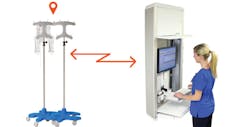Not too long ago healthcare organizations considered extending beyond bar coding to electronically track assets — people, including patients and staff, products and equipment — a luxury, a goal or even a dream.
How quaint. Some might even classify it as short-sighted.
In today’s budget-conscious and economically stressed environment, however, tracking assets represents a necessity that must happen. Bar coding remains a fundamental tool to match products and services to patients as well as reorder and restock supplies. But if you’re not using some type of real-time location system (RTLS) to move beyond line-of-sight recording, you’re behind the times, if not behind the 8-ball of clinical, financial and operational safety, security and serenity.
Historically, healthcare organizations cast a wary eye toward adoption and implementation of any RTLS platform, regardless of modality, due in large part to the perceived higher net costs of making it happen, which includes the actual higher costs of the technology itself, as well as the training curve and behavioral modification necessary to upset the status quo that may have just became comfortable with bar coding.
To promote the value of RTLS, manufacturers and first-moving providers embraced the return-on-investment the technology brought to their operations in terms of cost savings, efficiencies, process improvements and supply and service throughput and workflow visibility.
“The ROI argument for RTLS is very strong,” assured Sagi Geva, Director, Acute Care Solutions, STANLEY Healthcare, Waltham, MA. “Hospitals often document savings that pay for the system in less than a year.
Geva’s company, which is applying its AeroScout RTLS to BD Alaris’ infusion pumps in a recent partnership, indicated that ROI for asset management use cases can focus on three different areas:
- Preventing the loss of assets, such as infusion pumps in the trash and telemetry packs in the laundry.
- Generating capital/rental cost savings by reducing purchases/rentals through higher and more efficient asset utilization rates.
- Making labor more efficient, which translates to higher productivity for biomed techs that handle equipment cleaning, preventive maintenance, repairs, recall management and updates; and for clinical users of that equipment. Geva cited a study that reported 85 percent of nurses spend 60 minutes or more per shift searching for equipment. That can equate to 72,000 hours per year in lost productivity at a 300-bed hospital, he added.
“Hospitals should expect a prospective RTLS vendor to provide them with a detailed ROI analysis for all three factors, and specify the investment and likely return for their implementation,” he said.
RTLS can deliver accurate real-time visibility to resource locations and status, which improves communications and workflow according to Kevin Jackson, Chief Technologist, Versus Technology, a subsidiary of Midmark Corp., Traverse City, MI. Jackson further noted that facility staff can use measures, such as Search Time and Staff Productivity to determine a baseline ROI.
“However, while these soft gains may improve staff satisfaction and patient-caregiver interactions, solving equipment under-utilization issues is required to drive hard-dollar ROI,” Jackson continued. “For those charged with achieving measurable cost reductions based on acceptable accounting practices, an Asset Management solution with PAR-Level visibility, management and informatics-driven operational intelligence will improve utilization rates and deliver ROI on measures such as Asset Utilization, Inventory Turns, Capital Expense, Service Expense, Device Recall Efficiency, Preventive Maintenance, On-time Performance and Delayed PM Performance.”
Jackson cited as an example, the “generally accepted national average of hospital asset utilization is 40 percent, which means valuable assets such as IV pumps sit idle 60 percent of the time. That leaves significant opportunity to increase utilization by getting the equipment to the right people at the right time, and subsequently reduce inventory,” he added.
In addition to the potential savings gained by streamlining physical equipment acquisition, there are ancillary operational savings associated with purchasing less equipment, including less investment in service agreements, consumables, installation costs and user training, according to Jackson. These costs can significantly impact both capital and operating budgets, he said.
“From our experience, return-on-investment calculations are very specific to the end hospital client,” said Joe Pleshek, CEO, Terso Solutions, Fitchburg, WI. “We do find that most of the ROIs include one or more of the following value drivers: improved charge capture, labor savings, reduced carrying costs, lower expired product write-offs and enhanced regulatory compliance.”
Zebra Technologies offers a centralized view of management for any of its location technology beacons, as well as sensors/receivers that create actionable intelligence by determining location information and by assigning status and condition changes, said Chris Sullivan, Global Healthcare Practice Lead, Zebra Technologies, Lincolnshire, IL. “This information is displayed through customizable dashboards showing real time key performance metrics,” he noted. “Through the delivery of operational performance metrics, critically required baseline data is captured and performance improvements are measured. It is only through the creation of this quantifiable data that meaningful ROI calculations can be determined and cost justification obtained.”
Jatinder Sihra, Global Marketing Director, Digital Solutions, GE Healthcare, Milwaukee, stressed that her company’s Encompass RTLS can cost up to 60 percent lower than cabled RTLS because it doesn’t require an on-site server for the hospital to maintain and no dedicated software to update. “The system readily scales to accommodate growth and can be easily reconfigured if hospital layouts are redesigned or repurposed,” she added.
Sihra emphasized a cost-effective RTLS deployment ultimately provides clear benefits in three areas:
- Patient care: “RTLS helps ensure mobile assets are delivered when patients need them, helps caregivers provide prompt diagnosis and treatment, and enables nurses to spend more time on patient care, rather than looking for devices.”
- Operation efficiency: “Staff members easily and quickly locate equipment; time spent searching is greatly reduced. Biomedical staff can locate equipment to perform timely and compliant planned maintenance.”
- Financial performance: “Mobile device inventory is right-sized and capital, maintenance and labor costs reduced. Loss, theft, and rental of mobile assets like IV pumps and telemetry boxes may be minimized.”
Healthcare organizations need to evaluate the total cost of ownership (TCO) of the solution as well as the benefits that would be realized by that provider organization from that solution, urged Sandy Murti, Senior Director, Industry Solutions & Business Development, Impinj Inc., Seattle. “When we work with customers or our partners, we recommend they consider the following drivers of TCO:
- What is the infrastructure cost for a given asset management use case?
- What are the tag types that will be needed, and how will the tags be placed on the equipment?
- What are the installation and integration costs associated with the fixed infrastructure?
- What are the ongoing support and maintenance costs for the total system?
In addition to TCO drivers, a healthcare organization should explore potential benefits, Murti continued. “On the other side of the equation,” he said, “what are the benefits realized from the deployment of RAIN RFID-based systems?
- What does asset loss cost the organization today?
- How much time does your staff spend searching for equipment?
- What are your current asset utilization rates?
- How much does your organization spend on equipment rental or new equipment purchasing annually and what reductions can you expect?
- Will your biomed department productivity rise with the elimination of manual asset tracking tasks?
Adam Peck, Vice President, Marketing, CenTrak Inc., Newtown, PA, contended that how you measure the ROI from a Location Services platform remains heavily dependent on the asset type, uses, cases deployed and the facility’s key objectives. As a result, Peck indicated, each hospital should determine its own key performance indicators (KPIs).
“Beyond the ability to save time searching for a piece of equipment, improved utilization rates is one important aspect many facilities use to measure the success of their asset tracking and management solution,” Peck said. “If utilization rates are improved, that typically translates to reduced costs in rentals or equipment purchases, as well as ensuring PAR-levels are effectively managed.”
Staff efficiency can be measured in a variety of ways, according to Peck. “With the ability to automate clinical workflow, such as nurse call cancellation, electronic health record documentation, and rounding logs, one metric frequently used is the difference in time spent with patients vs. administrative tasks after a real-time location system has been implemented,” he said. “Improved hand-hygiene compliance rates and reduced healthcare-acquired infections (HAI) are additional metrics that can be used to measure the ROI of staff locating and the effectiveness of an enterprise location services program.”
Real-time tracking of the patient journey at admission, during his or her stay, and at discharge can help healthcare facilities significantly improve various aspects of patient flow, Peck continued. “Let’s use automated patient discharge as an example,” he said. “When a patient is discharged from a facility, the patient places their RTLS tag, which is attached to the hospital ID bracelet, in a designated dropbox. This dropbox, equipped with CenTrak’s RTLS technology, captures the patient ID and immediately notifies the cleaning staff that the room is unoccupied — reducing costly delays in communication and patient wait times for the next available bed. More effective patient management often creates greater patient throughput, reduced length of stay and higher bed turnover rates — all of which are great KPIs to evaluate.”
About the Author
Rick Dana Barlow
Senior Editor
Rick Dana Barlow is Senior Editor for Healthcare Purchasing News, an Endeavor Business Media publication. He can be reached at [email protected].








